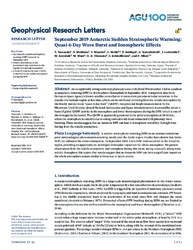September 2019 Antarctic Sudden Stratospheric Warming: Quasi-6-Day Wave Burst and Ionospheric Effects
Siddiqui, T.
Kervalishvili, G.
Laštovi?ka, J.
Kozubek, M.
Ward, W.
Themens, D. R.
Kristoffersen, S.
DOI: https://doi.org/10.1029/2019GL086577
Persistent URL: http://resolver.sub.uni-goettingen.de/purl?gldocs-11858/9329
Persistent URL: http://resolver.sub.uni-goettingen.de/purl?gldocs-11858/9329
Yamazaki, Y.; Matthias, V.; Miyoshi, Y.; Stolle, C.; Siddiqui, T.; Kervalishvili, G.; Laštovi?ka, J.; Kozubek, M.; Ward, W.; Themens, D. R.; Kristoffersen, S.; Alken, P., 2020: September 2019 Antarctic Sudden Stratospheric Warming: Quasi-6-Day Wave Burst and Ionospheric Effects. In: Geophysical Research Letters, Band 47, 1, DOI: 10.1029/2019GL086577.
 |
Dokument öffnen: |
An exceptionally strong stationary planetary wave with Zonal Wavenumber 1 led to a sudden stratospheric warming (SSW) in the Southern Hemisphere in September 2019. Ionospheric data from European Space Agency's Swarm satellite constellation mission show prominent 6-day variations in the dayside low-latitude region at this time, which can be attributed to forcing from the middle atmosphere by the Rossby normal mode “quasi-6-day wave” (Q6DW). Geopotential height measurements by the Microwave Limb Sounder aboard National Aeronautics and Space Administration's Aura satellite reveal a burst of global Q6DW activity in the mesosphere and lower thermosphere during the SSW, which is one of the strongest in the record. The Q6DW is apparently generated in the polar stratosphere at 30–40 km, where the atmosphere is unstable due to strong vertical wind shear connected with planetary wave breaking. These results suggest that an Antarctic SSW can lead to ionospheric variability through wave forcing from the middle atmosphere.
Statistik:
ZugriffsstatistikSammlung:
Schlagworte:
sudden stratospheric warmingquasi-6-day wave
planetary wave
ionosphere
vertical coupling
Swarm
This is an open access article under the terms of the Creative Commons Attribution License, which permits use, distribution and reproduction in any medium, provided the original work is properly cited.

